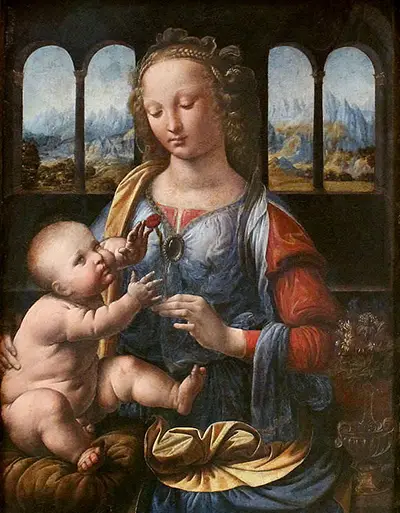The work is believed to have been painted in the late 15th Century, between 1472 and 1480. It is the only work by Da Vinci which is now on permanent display in a German museum.
Madonna with Child was a common motif for Middle Ages and Renaissance artists. Other well-known depictions of the subject include those by Raphael and Torelli. It has also been commonly depicted in statues, including at Norte Dame Cathedral in Ottawa Canada.
Da Vinci's depiction of Madonna of the Carnation is, at first glance, a relatively conventional take and similar to those by other artists of the same period. The depiction of the baby Jesus is somewhat more lifelike than in other examples of the Madonna and Child motif.
He is clearly an infant and appears slightly helpless and bewildered by his surroundings as he reaches out somewhat awkwardly for the symbol of the passion held in Mary's hand. The baby Jesus is awake and interacting with the Madonna rather than asleep and cradled in her arms as he is in many other depictions.
This gives Da Vinci's image a sense of life that other depictions can lack. The decision to portray Jesus as a real human infant, rather than a deity makes Da Vinci's painting relatable and recognisable to a wide audience.
Unfortunately, in comparison with other Da Vinci paintings, Madonna of the Carnation has deteriorated significantly over the years. This is in part due to a botched restoration attempt. The painting has taken on an weathered and leathery look.
This is particularly obvious in the detailing on and around the Madonna's face. It's likely that most of the original was painted over by a Flemish artist at some point before the painting's acquisition by the Munich gallery.
The style used here by Da Vinci reminds many of the later academic painters such as William Bouguereau, Jean-Léon Gérôme and Lawrence Alma Tadema.
The attribution of Madonna of the Carnation to Da Vinci was not immediate. For a period of time, most art historians believed that the work had been created by Verrocchio. Later, the work was attributed to Da Vinci and more recent research backs up this assertion.
If Da Vinci created the work as early as 1472, as has been suggested by some, then he would have done so while working in the workshop of Andrea del Verrocchio, which he joined at the age of 14. Despite completing his qualifications at the age of 20 in 1472, Da Vinci remained loyal to Verrocchio and continued to practice in his workshop for several more years.
Madonna of the Carnation is a fascinating example of Da Vinci's early work. Unfortunately, it's deterioration and the botched restoration attempt mean that it has not received the same level of attention as other paintings from this period of Da Vinci's life.


